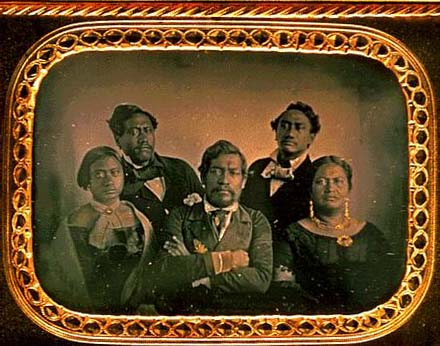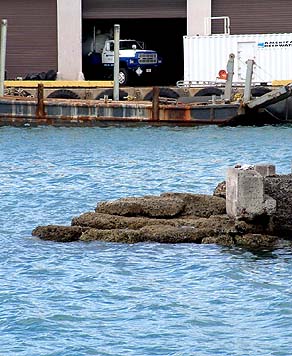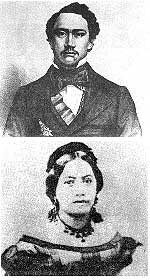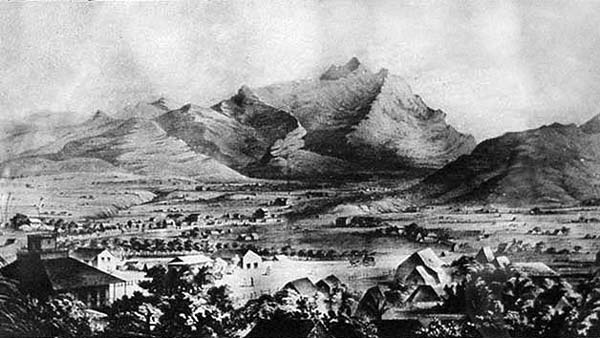 |
 |
 |
|||||||||||||||||||||
|
|
|
|
|
|
|
|
|
||||||||||||||||
|
|
|||||||||||||||||||||||
|
|
|
|
|
|
||
| “After the battle of Nu‘uanu, Kamehameha went and set up fort at the base of Fort Street," Mel reminds us. Thus Honolulu was a royal ahupua‘a. While before Kamehameha the chiefs lived primarily in Waikiki, Nu‘uanu had still been a major food producing area. "The big evidence is the very famous heiau on Punchbowl," Stephen adds, "and there were other heiau all throughout this valley. These heiau originally were associated with agriculture. Then about the 12th century, with the arrival of the ali‘i, they were associated with political power and the sacrifice. "When Kamehameha came up this valley to conquer O‘ahu, the big battles were fought in the lower area, because it was a seat of power. The power, the chiefs— were tied to the heiau. So often battles went from one heiau to another, to destroy the spiritual base of the chief and his priests."
|
||
|
|
||
|
“Kamehameha stayed on O‘ahu," Mel continues. "He was working this valley, and made this valley produce: fixed the auwai, planted taro, right down to Honolulu. The yam was growing, there were vegetables, so his people were healthy. His warriors came and set up camp down Honolulu harbor, and they were healthy, they were eating good food. That was in place, and when Kamehameha II came up here, he built the house up there--Kaniakapupu--for the brother, Kauikeouli. Kauikeaouli, who became Kamehameha III, lived on Maui for eight years and set up the Hawaiian government over here. Upon his return, he lived first at Pohukaina and then moved into what became the first ‘Iolani Palace. Successive monarchs would likewise take up residence in the Palace, but Kamehameha III is one of two Hawaiian royals who also maintained a strong link to Nu‘uanu itself. "Down there is hot," Mel explains. "The cool place is up here, so he was always up here.”
|
|
|
|
It was Kauikeaouli--Kamehameha III--who executed the Mahele under pressure from the missionaries and other foreign forces. Missionaries were putting forth the argument that private land ownership would give ordinary Hawaiians more incentive to use their lands productively and for profit. Others have since argued that the missionaries were trying to break the power of the ali‘i over land and labor. American notions of democracy played a strong role in this thinking. The recently formed United States had, only two or three generations earlier, thrown off the control of the British Monarchy. So to these Americans, monarchy was an oppressive form of government that needed to be replaced. Privatizing the land was seen as a step in that direction, since the ali‘i controlled the land.
|
|
|
|
|
|
| "With his advisors, Kauikeaouli looking for a way to sort of nail down something for Hawaiians—ordinary, non-ali‘i Hawaiians." Lynette remarks. "Something about him speaks of foresight, about being able to look down the road and make some preparation for what was coming. And so Kamehameha III’s prominence in the whole ali‘i line, except for the Queen, Kamehameha III’s role in who we are and how this land is defined, became very prominent." Kauikeaouli was considering his options carefully. Knowing that the Hawaiian land system would need to be changed in order to preserve the Kingdom from possible foreign aggression, yet not wishing to dismantle the entire Hawaiian political structure based on land control, he chose a path he felt would best maintain the integrity of the Hawaiian way in the face of inevitable change.
|
||
|
|
||
"By the time of the Mahele, the Hawaiian government was instituting other Western forms," Stephen says. "The pre-Kamehameha term ali‘i-‘ai-moku (for the chief who rules an island) was changing by Kamehameha’s time, and especially by the time Kauikeaouli established a constitution. You see the Westernized term “the governor” of the island, whose role I think would have been similar to that of the traditional chief. The system was evolving." The changes brought by the Mahele constituted a fundamental transformation of the Hawaiian social and political system. The direct impacts are examed further as the aftermath of the Mahele.
|
||
|
|
||
| |
| |
|
|
 |
| Nu‘uanu Home | Map Library | Site Map | Hawaiian Islands Home | Pacific Worlds Home |
|
|
|||
| Copyright 2003 Pacific Worlds & Associates • Usage Policy • Webmaster |
|||








